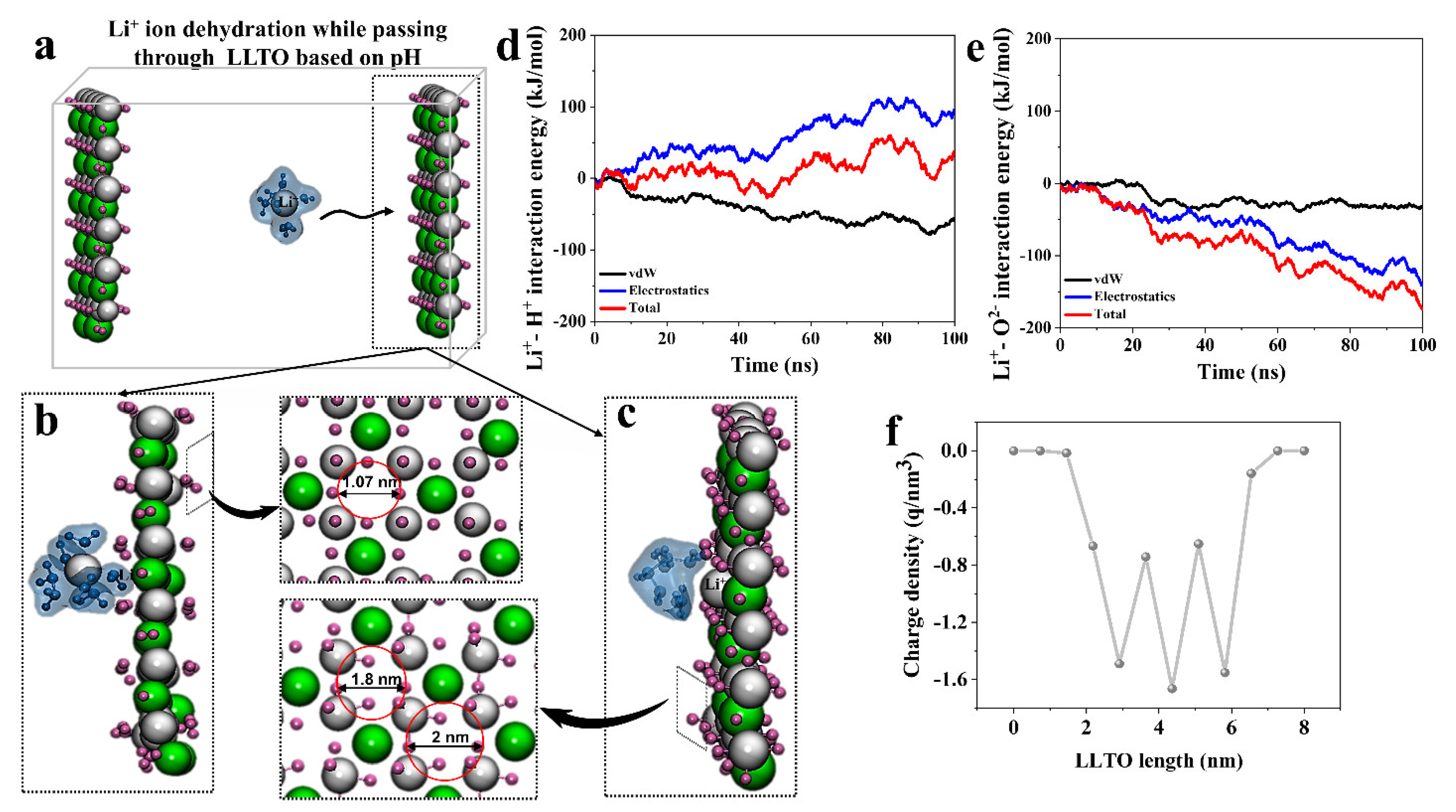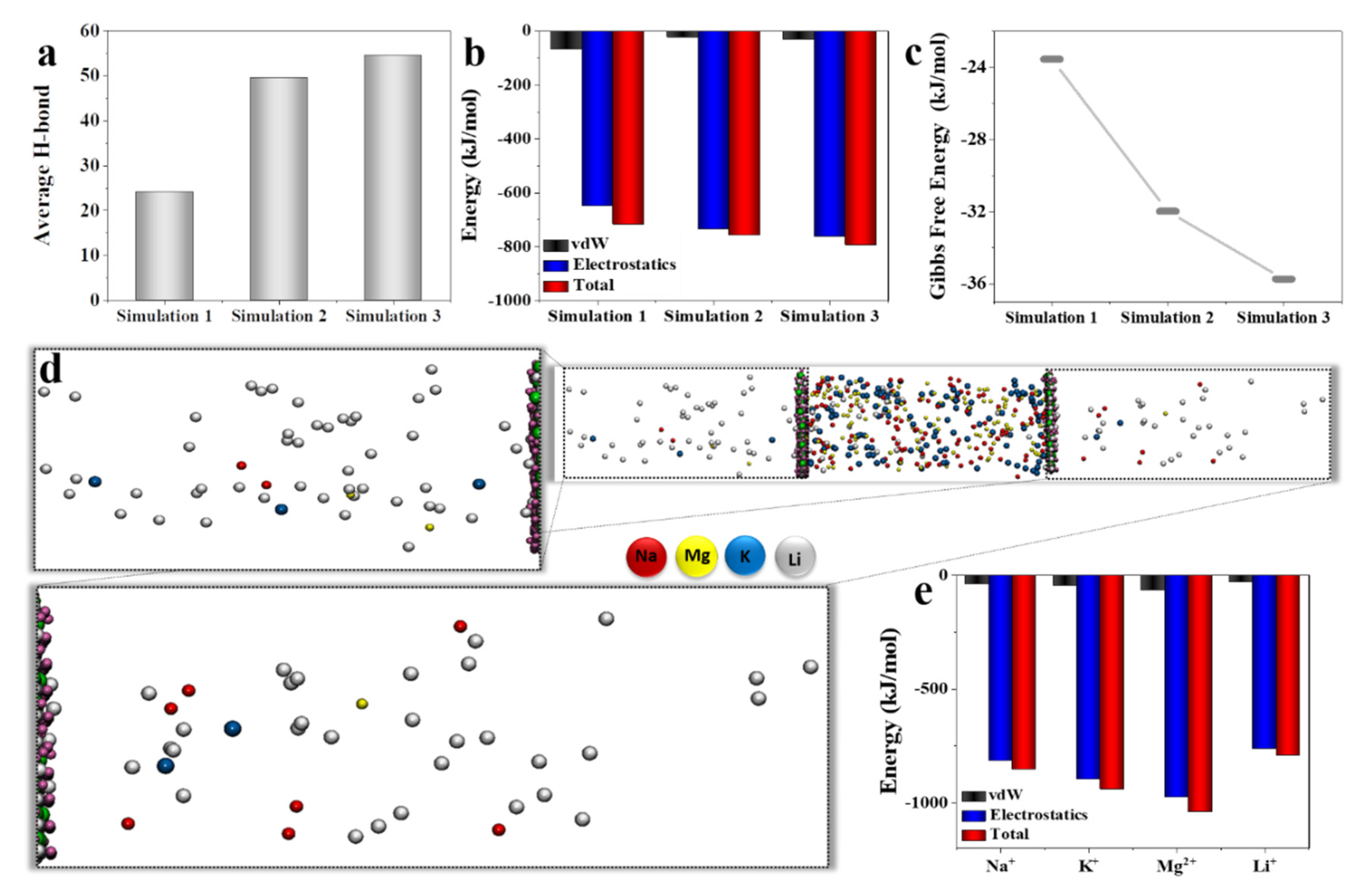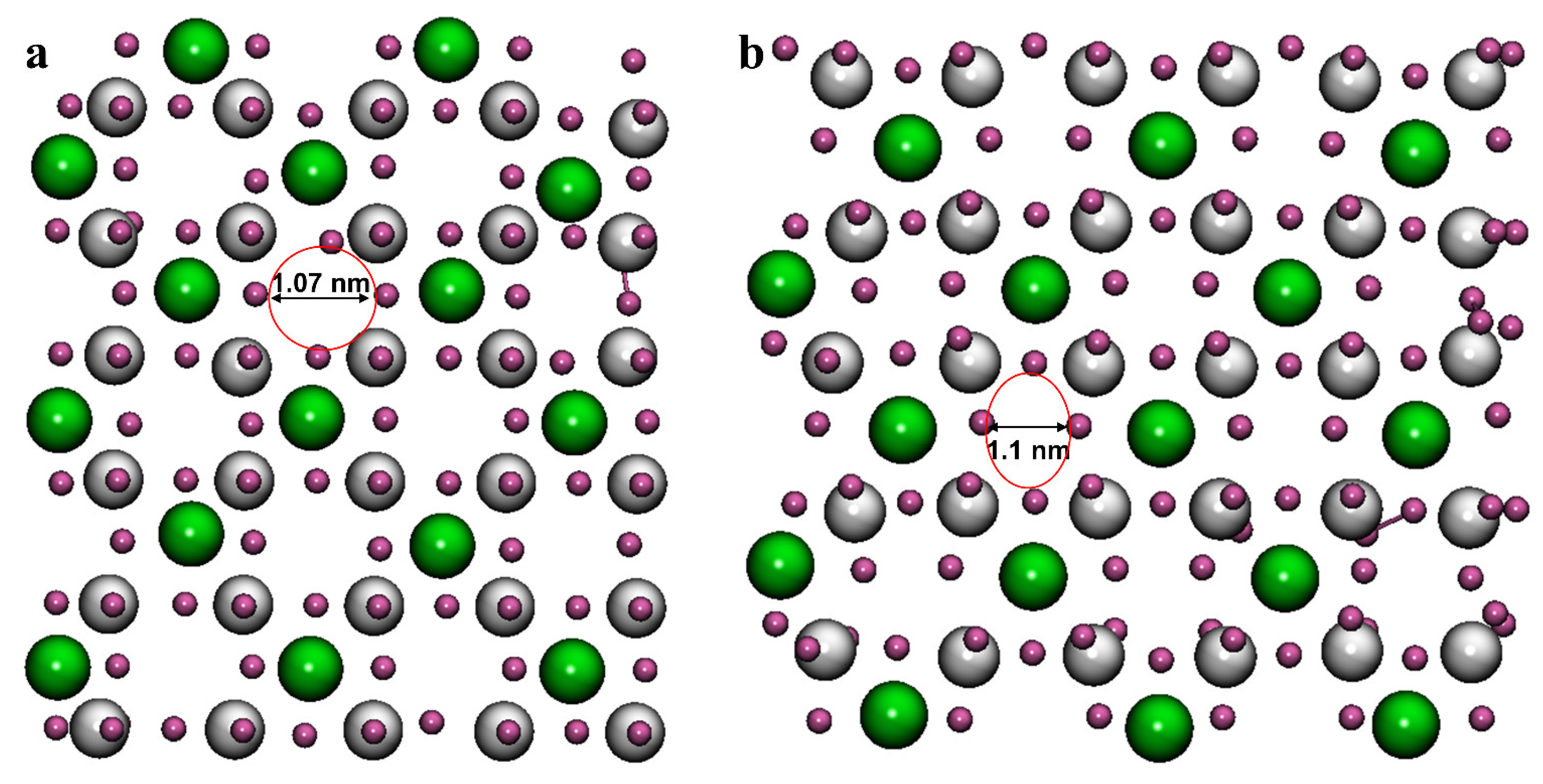Mechanism Understanding of Li-ion Separation Using A Perovskite-Based Membrane
Abstract
1. Introduction
2. Simulation Methods
2.1. Study Plan
2.2. Material and Methods
3. Results and Discussions
4. Conclusions
Author Contributions
Funding
Institutional Review Board Statement
Informed Consent Statement
Data Availability Statement
Conflicts of Interest
References
- Ajayi, O.S.; Oluyamo, S.S.; Ofiwe, C.U.; Aborisade, C.A. Zinc Oxide Nanoparticle in Lithium Triborate Microparticle System: Visibility for Application in Dosimetry. Mater. Today Proc. 2021, 38, 879–886. [Google Scholar] [CrossRef]
- Saray, A.A.; Kaviani, P.; Shahbazi-Gahrouei, D. Dosimetric Characteristics of Lithium Triborate (LiB3O5) Nanophosphor for Medical Applications. Radiat. Meas. 2021, 140, 106502. [Google Scholar] [CrossRef]
- Chen, T.; Jin, Y.; Lv, H.; Yang, A.; Liu, M.; Chen, B.; Xie, Y.; Chen, Q. Applications of Lithium-Ion Batteries in Grid-Scale Energy Storage Systems. Trans. Tianjin Univ. 2020, 26, 208–217. [Google Scholar] [CrossRef]
- Marín, P.E.; Milian, Y.; Ushak, S.; Cabeza, L.F.; Grágeda, M.; Shire, G.S.F. Lithium Compounds for Thermochemical Energy Storage: A State-of-the-Art Review and Future Trends. Renew. Sustain. Energy Rev. 2021, 149, 111381. [Google Scholar] [CrossRef]
- Cabeza, L.F.; Gutierrez, A.; Barreneche, C.; Ushak, S.; Fernández, Á.G.; Inés Fernádez, A.; Grágeda, M. Lithium in Thermal Energy Storage: A State-of-the-Art Review. Renew. Sustain. Energy Rev. 2015, 42, 1106–1112. [Google Scholar] [CrossRef]
- Wu, J.; Yuan, L.; Li, Z.; Xie, X.; Huang, Y. Air-Stable Means More: Designing Air-Defendable Lithium Metals for Safe and Stable Batteries. Mater. Horizons 2020, 7, 2619–2634. [Google Scholar] [CrossRef]
- Menazea, A.A.; Ismail, A.M.; Elashmawi, I.S. The Role of Li4Ti5O12 Nanoparticles on Enhancement the Performance of PVDF/PVK Blend for Lithium-Ion Batteries. J. Mater. Res. Technol. 2020, 9, 5689–5698. [Google Scholar] [CrossRef]
- Sun, Y.; Guan, P.; Liu, Y.; Xu, H.; Li, S.; Chu, D. Recent Progress in Lithium Lanthanum Titanate Electrolyte towards All Solid-State Lithium Ion Secondary Battery. Crit. Rev. Solid State Mater. Sci. 2019, 44, 265–282. [Google Scholar] [CrossRef]
- Siyal, S.H.; Javed, M.S.; Jatoi, A.H.; Lan, J.L.; Yu, Y.; Saleem, M.; Yang, X. In Situ Curing Technology for Dual Ceramic Composed by Organic–Inorganic Functional Polymer Gel Electrolyte for Dendritic-Free and Robust Lithium–Metal Batteries. Adv. Mater. Interfaces 2020, 7, 2000830. [Google Scholar] [CrossRef]
- Zhu, Y.; Gonzalez-Rosillo, J.C.; Balaish, M.; Hood, Z.D.; Kim, K.J.; Rupp, J.L.M. Lithium-Film Ceramics for Solid-State Lithionic Devices. Nat. Rev. Mater. 2020, 6, 313–331. [Google Scholar] [CrossRef]
- Hartmann, M.; Pfaffinger, M.; Stampfl, J.; Stampfl, J. The Role of Solvents in Lithography-Based Ceramic Manufacturing of Lithium Disilicate Cell-Compatible Hydrogels for Two-Photon Polymerization View Project Hydrogels for Two Photon Polymerization View Project The Role of Solvents in Lithography-Based Ceramic Manufacturing of Lithium Disilicate. Materials 2021, 14, 1045. [Google Scholar] [CrossRef]
- Mateus, R.; Costa, M.B.; Alves, L.C.; Guedes, M.; Alves, E.; Ferro, A.C. Lithium Dilution in Li-Sn Alloys. Nucl. Mater. Energy 2020, 25, 100783. [Google Scholar] [CrossRef]
- Liang, C.; Gao, M.; Pan, H.; Liu, Y.; Yan, M. Lithium Alloys and Metal Oxides as High-Capacity Anode Materials for Lithium-Ion Batteries. J. Alloys Compd. 2013, 575, 246–256. [Google Scholar] [CrossRef]
- Nithyadharseni, P.; Reddy, M.V.; Nalini, B.; Kalpana, M.; Chowdari, B.V.R. Sn-Based Intermetallic Alloy Anode Materials for the Application of Lithium Ion Batteries. Electrochim. Acta 2015, 161, 261–268. [Google Scholar] [CrossRef]
- Stringfellow, W.T.; Dobson, P.F. Technology for the Recovery of Lithium from Geothermal Brines. Energies 2021, 14, 6805. [Google Scholar] [CrossRef]
- U.S. Geological Survey. Mineral Commodity Summaries 2021; Geological Survey: Reston, VA, USA, 2021; 200p. [Google Scholar] [CrossRef]
- Yang, S.; Zhang, F.; Ding, H.; He, P.; Zhou, H. Lithium Metal Extraction from Seawater. Joule 2018, 2, 1648–1651. [Google Scholar] [CrossRef]
- Li, Z.; Li, C.; Liu, X.; Cao, L.; Li, P.; Wei, R.; Li, X.; Guo, D.; Huang, K.W.; Lai, Z. Continuous Electrical Pumping Membrane Process for Seawater Lithium Mining. Energy Environ. Sci. 2021, 14, 3152–3159. [Google Scholar] [CrossRef]
- Lai, X.; Xiong, P.; Zhong, H. Extraction of Lithium from Brines with High Mg/Li Ratio by the Crystallization-Precipitation Method. Hydrometallurgy 2020, 192, 105252. [Google Scholar] [CrossRef]
- Zhang, Y.; Hu, Y.; Wang, L.; Sun, W. Systematic Review of Lithium Extraction from Salt-Lake Brines via Precipitation Approaches. Miner. Eng. 2019, 139, 105868. [Google Scholar] [CrossRef]
- Kuai, Y.; Yao, W.; Ma, H.; Liu, M.; Gao, Y.; Guo, R. Recovery Lithium and Potassium from Lepidolite via Potash Calcination-Leaching Process. Miner. Eng. 2021, 160, 106643. [Google Scholar] [CrossRef]
- Wang, S.; Chen, X.; Zhang, Y.; Zhang, Y.; Zheng, S. Lithium Adsorption from Brine by Iron-Doped Titanium Lithium Ion Sieves. Particuology 2018, 41, 40–47. [Google Scholar] [CrossRef]
- Iizuka, A.; Yamashita, Y.; Nagasawa, H.; Yamasaki, A.; Yanagisawa, Y. Separation of Lithium and Cobalt from Waste Lithium-Ion Batteries via Bipolar Membrane Electrodialysis Coupled with Chelation. Sep. Purif. Technol. 2013, 113, 33–41. [Google Scholar] [CrossRef]
- Ji, Z.Y.; Chen, Q.B.; Yuan, J.S.; Liu, J.; Zhao, Y.Y.; Feng, W.X. Preliminary Study on Recovering Lithium from High Mg2+/Li+ Ratio Brines by Electrodialysis. Sep. Purif. Technol. 2017, 172, 168–177. [Google Scholar] [CrossRef]
- Song, Y.; Zhao, Z. Recovery of Lithium from Spent Lithium-Ion Batteries Using Precipitation and Electrodialysis Techniques. Sep. Purif. Technol. 2018, 206, 335–342. [Google Scholar] [CrossRef]
- Lv, W.; Ruan, D.; Zheng, X.; Li, L.; Cao, H.; Wang, Z.; Zhang, Y.; Sun, Z. One-Step Recovery of Valuable Metals from Spent Lithium-Ion Batteries and Synthesis of Persulfate through Paired Electrolysis. Chem. Eng. J. 2021, 421, 129908. [Google Scholar] [CrossRef]
- Liu, X.; Chen, X.; He, L.; Zhao, Z. Study on Extraction of Lithium from Salt Lake Brine by Membrane Electrolysis. Desalination 2015, 376, 35–40. [Google Scholar] [CrossRef]
- Li, Q.; Liu, H.; He, B.; Shi, W.; Ji, Y.; Cui, Z.; Yan, F.; Mohammad, Y.; Li, J. Ultrahigh-Efficient Separation of Mg2+/Li+ Using an in-Situ Reconstructed Positively Charged Nanofiltration Membrane under an Electric Field. J. Memb. Sci. 2022, 641, 119880. [Google Scholar] [CrossRef]
- Luo, H.; Peng, H.; Zhao, Q. High Flux Mg2+/Li+ Nanofiltration Membranes Prepared by Surface Modification of Polyethylenimine Thin Film Composite Membranes. Appl. Surf. Sci. 2022, 579, 152161. [Google Scholar] [CrossRef]
- Yang, Z.; Fang, W.; Wang, Z.; Zhang, R.; Zhu, Y.; Jin, J. Dual-Skin Layer Nanofiltration Membranes for Highly Selective Li+/Mg2+ Separation. J. Memb. Sci. 2021, 620, 118862. [Google Scholar] [CrossRef]
- Feng, Y.; Peng, H.; Zhao, Q. Fabrication of High Performance Mg2+/Li+ Nanofiltration Membranes by Surface Grafting of Quaternized Bipyridine. Sep. Purif. Technol. 2022, 280, 119848. [Google Scholar] [CrossRef]
- He, R.; Dong, C.; Xu, S.; Liu, C.; Zhao, S.; He, T. Unprecedented Mg2+/Li+ Separation Using Layer-by-Layer Based Nanofiltration Hollow Fiber Membranes. Desalination 2022, 525, 115492. [Google Scholar] [CrossRef]
- Wu, M.-B.; Ye, H.; Zhu, Z.-Y.; Chen, G.-T.; Ma, L.-L.; Liu, S.-C.; Liu, L.; Yao, J.; Xu, Z.-K. Positively-Charged Nanofiltration Membranes Constructed via Gas/Liquid Interfacial Polymerization for Mg2+/Li+ Separation. J. Memb. Sci. 2022, 644, 119942. [Google Scholar] [CrossRef]
- Peng, H.; Zhao, Q. A Nano-Heterogeneous Membrane for Efficient Separation of Lithium from High Magnesium/Lithium Ratio Brine. Adv. Funct. Mater. 2021, 31, 1–7. [Google Scholar] [CrossRef]
- Bashiri, A.; Nikzad, A.; Maleki, R.; Asadnia, M.; Razmjou, A. Rare Earth Elements Recovery Using Selective Membranes via Extraction and Rejection. Membranes 2022, 12, 80. [Google Scholar] [CrossRef] [PubMed]
- Xu, F.; Dai, L.; Wu, Y.; Xu, Z. Li+/Mg2+ Separation by Membrane Separation: The Role of the Compensatory Effect. J. Memb. Sci. 2021, 636, 119542. [Google Scholar] [CrossRef]
- Li, X.; Mo, Y.; Qing, W.; Shao, S.; Tang, C.Y.; Li, J. Membrane-Based Technologies for Lithium Recovery from Water Lithium Resources: A Review. J. Memb. Sci. 2019, 591, 117317. [Google Scholar] [CrossRef]
- Wang, G.X.; Yao, P.; Bradhurst, D.H.; Dou, S.X.; Liu, H.K. Structure Characterisation and Lithium Insertion in La0.33NbO3 Perovskite. Solid State Ionics 1999, 124, 37–43. [Google Scholar] [CrossRef]
- Deng, Z.; Radhakrishnan, B.; Ong, S.P. Rational Composition Optimization of the Lithium-Rich Li3OCl1−XBrx Anti-Perovskite Superionic Conductors. Chem. Mater. 2015, 27, 3749–3755. [Google Scholar] [CrossRef]
- Inaguma, Y.; Liquan, C.; Itoh, M.; Nakamura, T.; Uchida, T.; Ikuta, H.; Wakihara, M. High Ionic Conductivity in Lithium Lanthanum Titanate. Solid State Commun. 1993, 86, 689–693. [Google Scholar] [CrossRef]
- Chen, C.H.; Amine, K. Ionic Conductivity, Lithium Insertion and Extraction of Lanthanum Lithium Titanate. Solid State Ionics 2001, 144, 51–57. [Google Scholar] [CrossRef]
- Abhilash, K.P.; Selvin, P.C.; Nalini, B.; Nithyadharseni, P.; Pillai, B.C. Investigations on Pure and Ag Doped Lithium Lanthanum Titanate (LLTO) Nanocrystalline Ceramic Electrolytes for Rechargeable Lithium-Ion Batteries. Ceram. Int. 2013, 39, 947–952. [Google Scholar] [CrossRef]
- Ruiz, A.I.; López, M.L.; Veiga, M.L.; Pico, C. Electrical Properties of La1.33−xLi3xTi2O6 (0.1 < x < 0.3). Solid State Ionics 1998, 112, 291–297. [Google Scholar] [CrossRef]
- Hayamizu, K.; Seki, S.; Haishi, T. 7Li NMR Diffusion Studies in Micrometre-Space for Perovskite-Type Li0.33La0.55TiO3 (LLTO) Influenced by Grain Boundaries. Solid State Ionics 2018, 326, 37–47. [Google Scholar] [CrossRef]
- Yashima, M.; Itoh, M.; Inaguma, Y.; Morii, Y. Crystal Structure and Diffusion Path in the Fast Lithium-Ion Conductor La0.62Li0.16TiO3. J. Am. Chem. Soc. 2005, 127, 3491–3495. [Google Scholar] [CrossRef] [PubMed]
- Xu, S.; Song, J.; Bi, Q.; Chen, Q.; Zhang, W.M.; Qian, Z.; Zhang, L.; Xu, S.; Tang, N.; He, T. Extraction of Lithium from Chinese Salt-Lake Brines by Membranes: Design and Practice. J. Memb. Sci. 2021, 635, 119441. [Google Scholar] [CrossRef]
- Razmjou, A.; Hosseini, E.; Cha-Umpong, W.; Korayem, A.H.; Asadnia, M.; Moazzam, P.; Orooji, Y.; Karimi-Maleh, H.; Chen, V. Effect of Chemistry and Geometry of GO Nanochannels on the Li Ion Selectivity and Recovery. Desalination 2020, 496, 114729. [Google Scholar] [CrossRef]
- Kumar, G.; Mishra, R.R.; Verma, A. Introduction to Molecular Dynamics Simulations. In Lecture Notes in Applied and Computational Mechanics; Springer: Singapore, 2022; Volume 99, pp. 1–19. ISBN 3000126414. [Google Scholar]
- Mehdizadeh Chellehbari, Y.; Sayyad Amin, J.; Zendehboudi, S. How Does a Microfluidic Platform Tune the Morphological Properties of Polybenzimidazole Nanoparticles? J. Phys. Chem. B 2022, 126, 308–326. [Google Scholar] [CrossRef]
- Hess, B.; Bekker, H.; Berendsen, H.J.C.; Fraaije, J.G.E.M. LINCS: A Linear Constraint Solver for Molecular Simulations. J. Comput. Chem. 1997, 18, 14631472. [Google Scholar] [CrossRef]
- Zakertabrizi, M.; Hosseini, E.; Korayem, A.H.; Razmjou, A.; Fane, A.G.; Chen, V. Insight from Perfectly Selective and Ultrafast Proton Transport through Anhydrous Asymmetrical Graphene Oxide Membranes under Grotthuss Mechanism. J. Memb. Sci. 2021, 618, 118735. [Google Scholar] [CrossRef]
- Hydrogen Bond—GROMACS 2022.3 Documentation. Available online: https://manual.gromacs.org/current/reference-manual/analysis/hydrogen-bonds.html (accessed on 11 October 2022).
- Smith, D.W. Ionic Hydration Enthalpies. J. Chem. Educ. 1977, 54, 540–542. [Google Scholar] [CrossRef]



| Part | Simulation No. | Temp. (K) | pH | Solvent | Num. Of Ions/Ion Type |
|---|---|---|---|---|---|
| 1st | 1 | 298 | 7 | Water | 1 Li+ |
| 2 | 323 | 5.5 | Water | 1 Li+ | |
| 3 | 323 | 5.5 | Water | 125 Li+, 125 K+, 125 Na+, and 125 Mg2+ | |
| 2nd | 4 | 298 | - | - | 0 |
| 5 | 323 | - | - | 0 |
| Ion | Bare Ion Radius | Hydrated Radius | Hydration Number | Diffusion Coefficient | Hydration Free Energy |
|---|---|---|---|---|---|
| [nm] | [nm] | ±1 | (10−9 m2 s−1 ) | [kJ. mol−1] | |
| H3O+ | - | 0.28 | 3 | 9.31 | - |
| Li+ | 0.068 | 0.38 | 5 | 1.03 | 474 |
| Na+ | 0.095 | 0.36 | 4 | 1.33 | 364 |
| K+ | 0.133 | 0.33 | 3 | 1.96 | 295 |
| Mg+ | 0.065 | 0.43 | 6 | 0.71 | 1828 |
Publisher’s Note: MDPI stays neutral with regard to jurisdictional claims in published maps and institutional affiliations. |
© 2022 by the authors. Licensee MDPI, Basel, Switzerland. This article is an open access article distributed under the terms and conditions of the Creative Commons Attribution (CC BY) license (https://creativecommons.org/licenses/by/4.0/).
Share and Cite
Golmohammadi, M.; Habibi, M.; Rezvantalab, S.; Mehdizadeh Chellehbari, Y.; Maleki, R.; Razmjou, A. Mechanism Understanding of Li-ion Separation Using A Perovskite-Based Membrane. Membranes 2022, 12, 1042. https://doi.org/10.3390/membranes12111042
Golmohammadi M, Habibi M, Rezvantalab S, Mehdizadeh Chellehbari Y, Maleki R, Razmjou A. Mechanism Understanding of Li-ion Separation Using A Perovskite-Based Membrane. Membranes. 2022; 12(11):1042. https://doi.org/10.3390/membranes12111042
Chicago/Turabian StyleGolmohammadi, Mahsa, Meysam Habibi, Sima Rezvantalab, Yasin Mehdizadeh Chellehbari, Reza Maleki, and Amir Razmjou. 2022. "Mechanism Understanding of Li-ion Separation Using A Perovskite-Based Membrane" Membranes 12, no. 11: 1042. https://doi.org/10.3390/membranes12111042
APA StyleGolmohammadi, M., Habibi, M., Rezvantalab, S., Mehdizadeh Chellehbari, Y., Maleki, R., & Razmjou, A. (2022). Mechanism Understanding of Li-ion Separation Using A Perovskite-Based Membrane. Membranes, 12(11), 1042. https://doi.org/10.3390/membranes12111042









